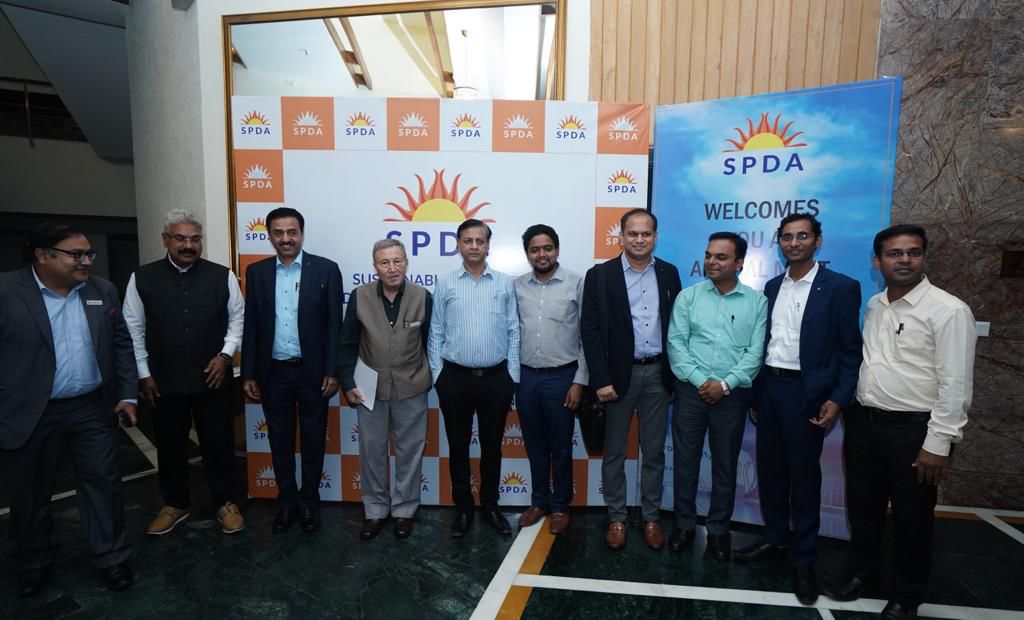The Solar Power Developers Association (SPDA), a ten-year-old industry body committed to promoting the renewable energy space, has rebranded itself as Sustainable Projects Developers Association (SPDA). The new brand identity reflects the association’s transition from representing pure-play renewable energy developers to that representing end-to-end solution providers across the decarbonization spectrum.
SPDA [Sustainable Projects Developers Association] has more than 40 member companies across solar, wind, hybrid, battery energy storage systems, green hydrogen, and green ammonia sectors. These member companies include leading RE players. Most of the members are also developing an active pipeline of green hydrogen and green ammonia projects in India.
Shekhar Dutt, director general of SPDA, and former governor of Chhattisgarh, said, “SPDA aims to provide a neutral platform and become the voice of the companies engaged in energy transition in the country. This new identity will also enable SPDA to expand its global outreach especially in countries where urgent transition towards clean energy is becoming the new mantra for Governments. SPDA will promote offerings across the spectrum that support decarbonization within the context of the future of energy.”
SPDA has already been leading the representation of emerging decarbonization solutions like green hydrogen and its derivatives, wind, solar, hybrid solutions, energy storage including pumped storage and batteries, carbon markets, solar module manufacturing and electrolyzer manufacturing. Its inputs/suggestions were well received by the government to come up with rules amendments/revisions such as ALMM exemption for projects to be commissioned up to March 31, 2024, commissioning extension for solar projects in bidding guidelines, ISTS charges waiver for green hydrogen and green ammonia, waiver of environmental clearance for green hydrogen and green ammonia, among a host of other key developments.
The Association looks to deepen further its engagement with policy advocacy, discussions, and consensus building on issues related to the energy transition.
Vineet Mittal, president of SPDA and chairman of Avaada Group, commented, “Round-the-clock renewables, green hydrogen, and its derivatives have emerged as potent alternatives to fossil fuels for advancing accelerated decarbonization across the sectors and geographies. India with its vast potential of renewable energy and skilled manpower is poised to play an important role in fulfilling global demand for green hydrogen and its derivatives.”
“SPDA’s primary goal is to widen the outreach of Indian developers, and represent their interests both in India and abroad in countries where there is demand for green fuels buoyed by their decarbonization targets. In its pursuit, SPDA will leverage its networking capabilities coupled with research-backed representations for effective and transformational policy advocacy.”
Sandeep Kashyap, COO-Ammonia, Acme Group, said, “The new identity not only signifies a commitment to bolstering India’s energy security but also to positioning the nation as a global hub for green energy innovation. We eagerly anticipate working towards our shared mission for a sustainable future.”
Ranjit Gupta, CEO of Ocior Energy, commented “Energy transition stands at the core of climate action and sustainable economic progress. In an ever-evolving sector, the role of SPDA in shaping green energy discussions cannot be overstated. With our commitment to a greener world, we applaud SPDA for its new direction and look forward to fruitful collaboration.”
At the unveiling of the new brand identity, the SPDA member discussed various issues facing the green hydrogen and derivatives market. They highlighted the need for hydrogen and derivative purchase obligations on sectors like fertilizers, transport, and oil refineries to create a domestic market for these products. The members said that similar to the feed-in-tariff (FIT) regime for wind and solar projects in some countries, there can be a fixed pricing mechanism for the offtake of green hydrogen and derivatives from producers.
Currently, fertilizer industry imports about 2-2.5 million tons of grey ammonia per year. The first target is to replace all the import contracts with domestic green contracts.
The members said electrolyzer forms a small portion of the overall project costs. While the government provides a subsidy for domestic electrolyzer manufacturing, it also needs to look at supporting states in enhancing their transmission infrastructure substantially.
Storage is going to be the most critical component in meeting the market demand. Unfortunately, lithium-based battery energy storage and pumped hydro storage are the only techno-commercially feasible options available. And with lithium battery energy storage, there are geopolitical, technical, and other issues.
Pumped hydro storage offers a huge advantage and higher returns than with lithium battery storage. However, only a few players are developing pumped storage projects, and that too for their own consumption. The SPDA members stated they are pushing the government to look at the possibility of development of pumped storage capacities by some private-sector players, just as in the case of the Bhadla solar park, which offers a plug-n-play facility to green hydrogen and derivative producers.
This content is protected by copyright and may not be reused. If you want to cooperate with us and would like to reuse some of our content, please contact: editors@pv-magazine.com.









By submitting this form you agree to pv magazine using your data for the purposes of publishing your comment.
Your personal data will only be disclosed or otherwise transmitted to third parties for the purposes of spam filtering or if this is necessary for technical maintenance of the website. Any other transfer to third parties will not take place unless this is justified on the basis of applicable data protection regulations or if pv magazine is legally obliged to do so.
You may revoke this consent at any time with effect for the future, in which case your personal data will be deleted immediately. Otherwise, your data will be deleted if pv magazine has processed your request or the purpose of data storage is fulfilled.
Further information on data privacy can be found in our Data Protection Policy.